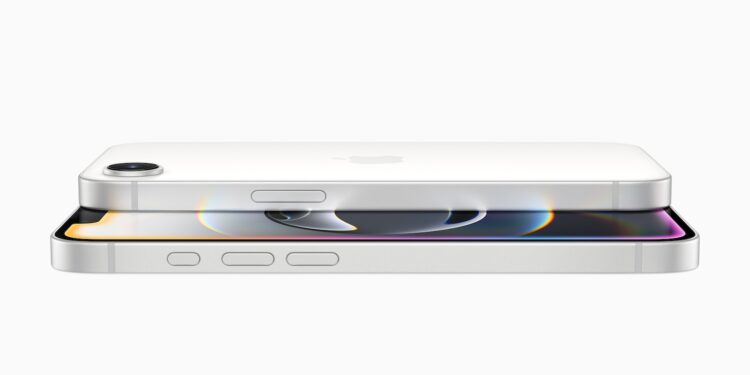Apple is once again leading the global smartphone charts – but this time at an unusual time. In the first quarter of 2025, a period usually dominated by Android manufacturers, Apple took the lead with a 19 percent market share. The iPhone 16e played a key role in this. The model was introduced earlier than usual and is selling particularly well in regions that Apple has previously treated as a secondary priority.
According to a report by Counterpoint Research, Apple overtook Samsung in global smartphone shipments in the first quarter of 2025. With a market share of 19 percent, Apple was ahead of Samsung's 18 percent. What's striking is not only the new top spot, but also the timing: Apple typically achieves its biggest sales figures in the fourth quarter, following the annual launch of new iPhones in the fall. That the company is now in the lead at the beginning of the year is an unusual development. The iPhone 16e, which Apple deliberately launched early in the year, is largely responsible for this.
Strong sales start for the iPhone 16e
The iPhone 16e came at the right time and met with high demand, especially in emerging markets. Apple achieved double-digit growth in Japan, India, Southeast Asia, and the Middle East and Africa. These markets had previously played only a minor role for the company. Now they are developing into key growth regions, as smartphone adoption in established markets such as North America, Europe, and China is largely saturated. In the US, Europe, and China, sales are stagnating or even declining. Nevertheless, Apple was able to grow globally – a sign that the shift in focus to emerging regions is working. The iPhone 16e was particularly well received there, partly because Apple specifically expanded sales and created locally tailored offerings.
The smartphone market is growing slightly again
The global smartphone market grew by three percent year-on-year in the first quarter of 2025. This was due to increased demand in China due to government subsidies, as well as an economic recovery in Latin America, the Asia-Pacific region, and other emerging markets. January was particularly strong, driven by new product launches such as Samsung's Galaxy S25 and Apple's iPhone 16e. Apple's decision to release the iPhone 16e earlier in the year shifts the company's usual sales cycle. In an era traditionally dominated by Android, Apple is now competitive – on par with Samsung (via Counterpoint Research).
Regional successes and strategic changes
Apple's ability to take the lead in the first quarter reflects a profound shift in its corporate strategy. While growth has stagnated in its core markets, Apple is now increasingly focusing on emerging markets. Smartphone penetration there is still ongoing, and demand continues to grow. Apple is responding with customized devices like the iPhone 16e, improved distribution channels, and a range of local services. India and Southeast Asia are now considered particularly promising markets. There, Apple is achieving unit sales volumes that are barely achievable in North America or Europe. The company is thus taking a different approach than before: no longer just premium, but also specifically targeting broader audiences – without losing the "Apple" trademark.
Uncertainties remain
Despite the positive development in the first quarter, there are also uncertainties. Analysts at Counterpoint Research warn of increasing economic uncertainty. Reasons include growing trade tensions, potential new tariffs in the US under Donald Trump, and persistently high inflation. These factors could weigh on consumer demand and dampen growth. Apple has reportedly slightly lowered its forecast for 2025 as a whole. Compared to 2024, the company expects a slight decline in smartphone shipments. Even strong brands like Apple are not immune to global economic conditions.
Competitors are catching up
Samsung had a slow start to the year, as the Galaxy S25 was launched later. However, the company caught up in March with strong sales of flagship and mid-range devices like the A series. The high-end S25 Ultra model, in particular, won over many buyers. Other manufacturers such as Xiaomi, Vivo, and OPPO are also among the top five brands worldwide. Vivo improved its ranking, primarily due to strong sales in China and continued growth in emerging markets. Huawei remains strong within China, while Honor and Motorola are gaining ground globally.
The iPhone 16e as a door opener for new markets
Apple's success in the first quarter of 2025 demonstrates how dramatically the smartphone market is changing. The iPhone 16e was more than just a new device—it was a strategic step toward new target groups and new markets. The early market launch gave Apple an advantage that is rare in an otherwise Android-dominated quarter. Nevertheless, the market is volatile. Global economic uncertainties could impact the rest of the year. Apple must therefore continue to be flexible—in products, pricing, market strategies, and regional focus. The iPhone 16e was a successful start. Whether this success can be sustained depends on the company's future course and external conditions. (Image: Apple)
- iPhone 16 vs. 16e: Apple C1 modem versus Qualcomm in test
- Buy iPhone 16e? These features make the difference
- Q2/2025: Apple to present figures on May 1 – and discuss tariffs





